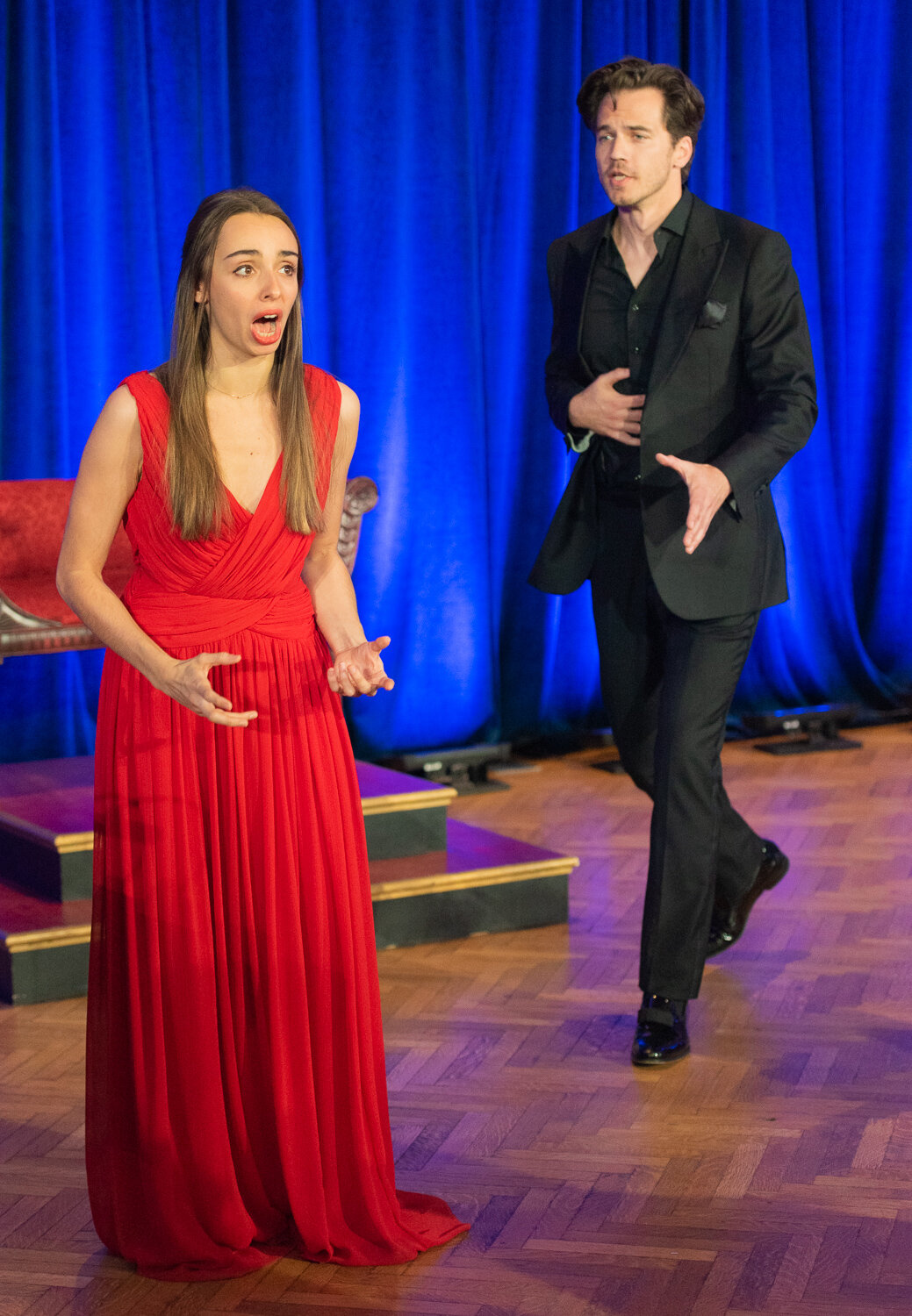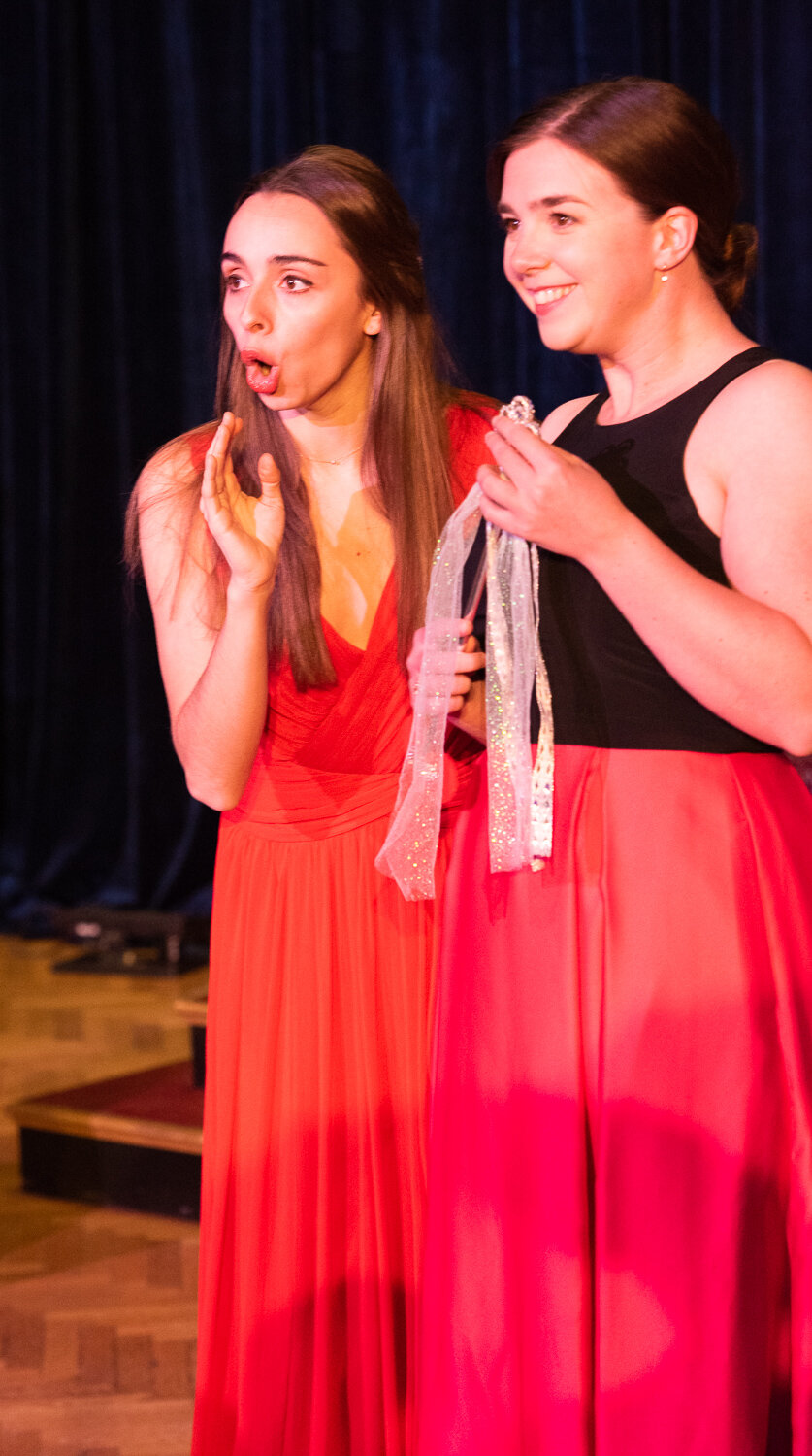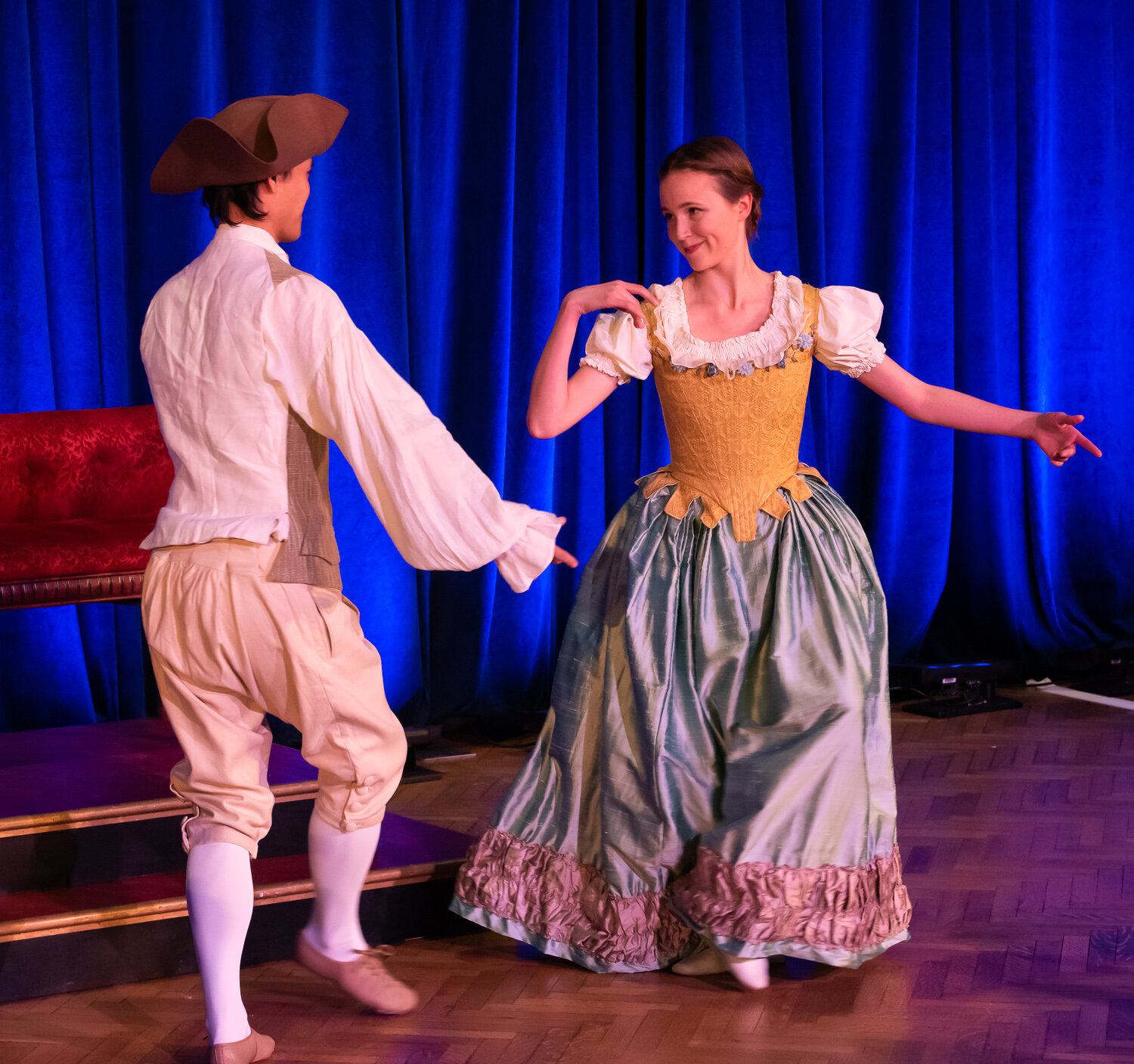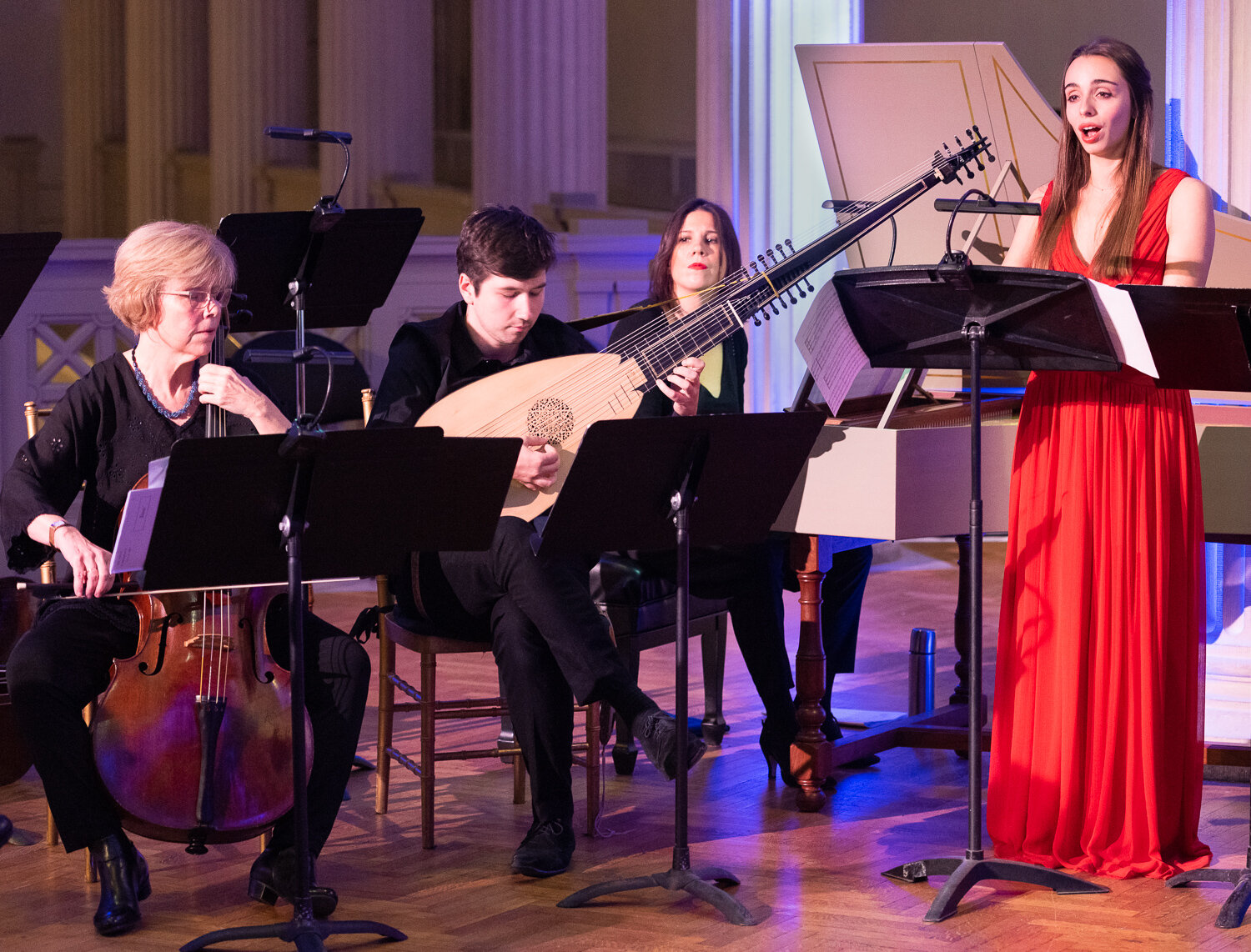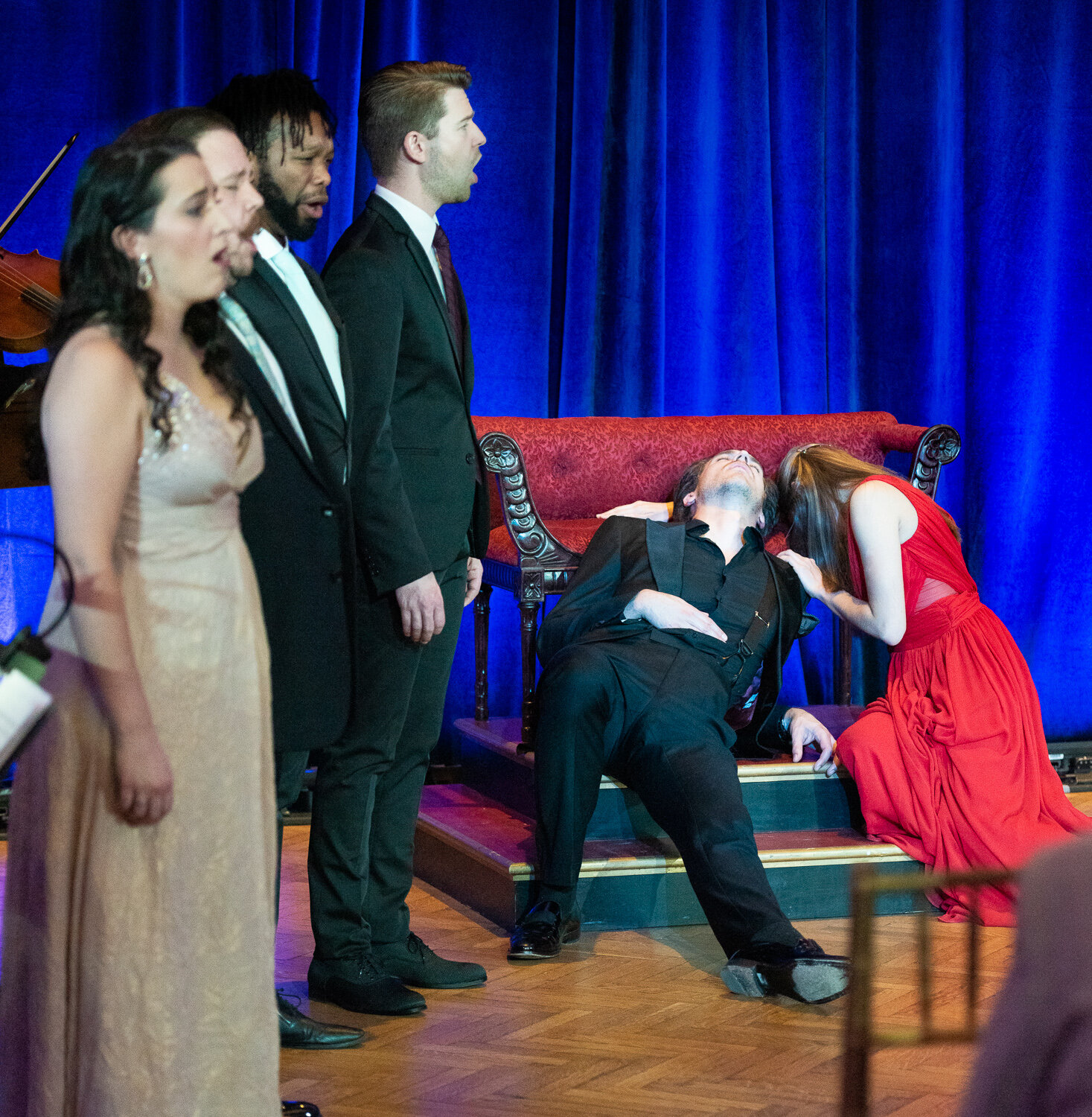Opera Lafayette is a class act, always. They never fail to bring out the crystal, the good china, real silverware, and their desserts are the best, made with authentic ingredients. On Thursday night’s menu was composer John Blow’s Venus and Adonis, or as I am calling this confection, Death by Baroque. Instead of a chocolate brownie, Blow’s extraordinary baroque music played on period instruments served as the base, and instead of chocolate syrup, it was ladled with gorgeous voices, and then complemented with precision Baroque dancers, rather than a dollop of vanilla ice cream. Yet more? The table was set among the palatial columns of the second story atrium in the Corcoran building, a modest simulation of the premiere of Venus and Adonis in 1683 at the court of Charles II of England. Here is my brief assessment of this concert: OL’s Death by Baroque was to die for.
l to r: Thomas Dunford, Lea Desandre, Daniel Moody, Patrick Kilbride, and Jonathan Woody open with songs. Rehearsal photo by Louis Forget; courtesy of Opera Lafayette.
Opera Lafayette celebrates its 25th season this year and, for this performance, returned to the venue of its early concerts; in those days, OL was named the Violins of Lafayette. Singing and dancing were soon added to the concert programs, eventually evolving to focus on opera, hence the name change; read OperaGene’s first blog report on Opera Lafayette at this link. The mission of OL is to perform, using period instruments, forgotten masterpieces of mainly 17th and 18th opera by French composers. Over their history, Founder and Artistic Director Ryan Brown has proven exceptionally adroit at finding these gems; I no longer try to decide if I want to see an Opera Lafayette production – I just go. While it has some connection to France through Charles II’s exile there, Venus and Adonis is the first through composed ‘English opera’. Charles brought back to England with him an enjoyment of French culture, including courtly entertainments.
left photo: Lea Desandre as Venus and Douglas Williams as Adonis. right photo: Lea Desandre as Venus and Sarah Shafer as Cupid. Rehearsal photos by Louis Forget; courtesy of Opera Lafayette.
Composer Blow worked as the King’s Composer, and this particular King and his court became known for carefree, even risqué behavior (for an uncensored assessment of the real King and his court, check out “A Satire of Charles II” by John Wilmot, 2nd Earl of Rochester; the story is that the Earl sent this poem by accident to King Charles which lead to a self-posed period of exile for his safety). It is notable that among the original cast was a mistress of the King and their illegitimate daughter. Fortunately for us, Mr. Blow chose the high road in producing classical entertainment. This is truly beautiful baroque music based on the classic story of Venus and Adonis from Ovid’s Metamorphoses and popularized by Shakespeare’s poem. His librettist, Anne Kingsmill Finch, a woman author, highly unusual for the times, could not resist tweaking the court with lyrics such as “Your women they continue true/Until they see another man” and shifting from Venus to Adonis who was distraught by him leaving to join the hunt. Those are but minor embellishments and must have been suffered gladly since I am unaware of any exile being imposed. The tale told in poetry keeps love and passion and loss at a highly romantic level, and the emotional impact was fully delivered by the team of voices. We all clutched our breasts and sadly sighed as Adonis spoke his last words after being gored in the hunt. It was as delicious as a large serving of Death by Chocolate.
Photo bookends are dancers Julia Bengsston and Matthew Ting. Singers l to r are Sarah Shafer, Jonathan Woody, Daniel Moody, Patrick McBride, and Véronique Filloux. Rehearsal photo by Louis Forget; courtesy of Opera Lafayette.
The program was led off and greatly enhanced by songs by John Dowland (1563-1626) and Henry Purcell (1659-1695); England’s famous opera composer Purcell was a student under Blow. The singers, mezzo-soprano Lea Desandre, countertenor Daniel Moody, tenor Patrick McBride, and bass-baritone Jonathan Woody delivered beautiful, perfectly toned sound. The visual expressivity by the guys, both during the songs and the opera, were a little over the top, but highly enjoyable, nonetheless. Lutist extraordinaire and Music Director for the evening Thomas Dunford accompanied the early songs and displayed amazing artistry; he has been referred to as the Eric Clapton of lute players. He was joined by the two additional Continuo players in the later songs, where there was a particularly enjoyable passage with Dunford and harpsichordist Violaine Cochard playing an interactive jazzy baroque riff together.
The semi-staged production of Venus and Adonis included a prologue and three acts, running just under an hour. The very high level of vocal and musical excellence continued as the initial vocalists were joined by the remaining cast and the OL orchestra, including Ryan Brown and Jacob Ashworth playing violin, Kyle Miller on viola, Anthony Manzo on base, Nina Stern on recorder, and Margaret Owens on recorder and Oboe – all superb musicians. Playing Venus was Ms. Desandre whose lovely voice and deftness at emotional intonation were a highlight; it would be difficult to over praise this young mezzo singing this music. Bass-baritone Douglas Williams sang well and looked the part of a dashing, handsome prince that the goddess of love might desire. The other specified role, that of Venus’ son Cupid, was sung handsomely by soprano Sarah Shafer. The additional singers played shepherds, shepherdesses, and huntsmen as needed, each getting a chance to shine, including soprano Véronique Filloux as well as aforementioned Moody, Kilbride, and Woody. I will single out Daniel Moody a bit more. I always feel that the countertenor is the singer that distinguishes baroque opera, and Mr. Moody’s clarion countertenor provided a strong beacon for this opera. In fact, the entire cast was a delight.
left photo: Dancers Matthew Ting and Julia Bengsston. right photo: Singer Véronique Filloux, dancers Matthew Ting, and Julia Bengsston. Rehearsal photos by Louis Forget; courtesy of Opera Lafayette.
In costumes appropriate to the period were dancers Julia Bengsston and Matthew Ting, whose movements throughout the opera added interest and charm. Their involvement was choreographed by Ms. Bengsston. The addition of white masks towards the end for the dancers and Ms. Filloux added a ghostly effect. I simply enjoyed the dancing, but for an interesting expert’s critique of this aspect of the performance, I refer you to a review by Susan Galbraith, who is experienced in musical drama. I personally detected no off flavors in any of this.
left photo: Loretta O’Sullivan, Thomas Dunford, Violaine Cochard, and Lea Desandre. right photo: Cast sings to mourn the fallen Adonis. Rehearsal photos by Louis Forget; courtesy of Opera Lafayette.
Opera Lafayette’s Venus and Adonis or Death by Baroque, what’s in a name? Opera Lafayette, originally Violins of Lafayette, has a motto for this year of ‘Celebrating 25 Years of Reawakening Masterpieces’. That I think is more a performer’s perspective. As a now devoted fan of Opera Lafayette, I would call them ‘Rediscovered Recipes for Delights’. Maybe there is something in a name.
The Fan Experience: OL performed Venus and Adonis once more, the next day, moving it to NYC. OL performs each production in both DC and NYC. Their next opera, Beethoven’s Leonore will play in DC on February 26 and in NYC on March 2.
Venus and Adonis is sung in English, and the program booklet contained lyrics for all the songs and the libretto for the opera which is very short. I find understanding even English when sung in operatic style problematic, but I gave up trying to go back and forth reading the lyrics and watching the performers and just enjoyed what I was seeing and hearing. I had gotten the gist of what was transpiring from my earlier quick scan of the program book.
It was quite a treat to get to see inside the Corcoran Building, which is formally named the Flagg Building. Until 2014, this was the Corcoran Gallery of Art before its art works were given to the National Gallery of Art, and the building was given to George Washington University. The building remains home to GWU’s Corcoran School of the Arts and Design. The Salon Dore’ or the French Room in the building was the actual spot for Opera Lafayette’s first performance; it is a relatively small, but absolutely gorgeous room.
The venue fit the history of OL and the intimacy of this performance beautifully. However, the acoustics and the lack of tiered seating would be issues for regular presentations there, not to mention that with its success, Opera Lafayette has way outgrown the size of this venue. Their next performance in DC will move back to the Kennedy Center; OL’s popularity has grown to the point that even there tickets can be hard to come by.


